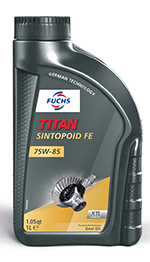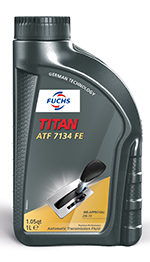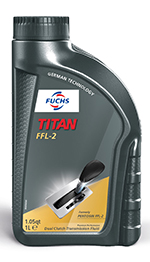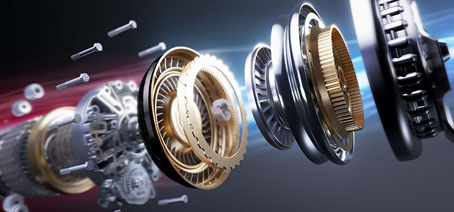Gear and transmission oils
Transmission types
Transmissions of different constructions and with different functions are mounted in all motorised vehicles. They primarily deal with speed adaptation between the engine and the drive axle, speed compensation between axles and wheels, and for changing direction in the powertrain. There is differentiation between manual transmission, automatic transmission, double clutch, power steering and hydraulic systems, and between gears in cars and commercial vehicles. When choosing the right gear oil for oil change or repair of the gearbox, the transmission type is crucial.
Requirements for gear oils
- Lubrication/wear protection
- “Synchro” compatibility
- High friction stability
- Oxidation stability
- Excellent foaming and air release ability
- High fuel efficiency
- Good shifting properties in the cold
- Corrosion protection
- High thermal stability
- Long drain intervals or even fill-for-life
- Reduced noise and vibrations
- High shear stability
- Compatibility with electric components/elements
- Load-carrying capacity (EP = Extreme Pressure)
- Release of contaminants and deposits
These far-reaching requirements can only be met if, from an application engineering point of view, the correct lubricant is used, in the required quantity, based on the operating conditions in the transmission. It is therefore important to pay close attention to the relevant oil specifications and OEM approvals for repairs and oil changes.
Gear oil types

Manual Transmission Fluids (MTFs)
In modern manual transmissions, in addition to classic wear reduction, the lubricant performs a wide variety of tasks and has an impact on ride comfort, as ease of gear shifting is decisively influenced by the lubricant.

Drivetrain oils
Some transmission oils are specifically developed for a particular application, which means for example using one oil for the gearbox and one for the hypoid gear. There are also transmission oils designed for the entire drivetrain. The advantage is that the same oil can be used in the gearbox, the gear transfer case and the hypoid gear. Important characteristics in a transmission oil are that it must offer high wear protection and not age too quickly, despite high loads and temperatures. In gearboxes with synchronisers, the oil has to allow the right friction and be compatible with the material in the vanes. Here too, longer intervals between replacement and in some cases fill-for-life are available. With stricter directives and regulations concerning emissions, transmission oils are increasingly focused on optimising efficiency in the drivetrain.

Automatic Transmission Fluids (ATFs)
The coefficient of friction is important to the function of automatic transmissions when opening and closing disc clutches and brakes. This is exactly what ATFs need to be customised for. Especially because of the different requirements that manufacturers of automatic transmissions have on coefficient of friction properties, and there is no general classification. OEM specifications are crucial for automatic transmission fluids.
Read more about the importance of customised ATFs here.

Continuously variable transmission fluids (CVTFs)
CVTFs are very similar to ATFs, but in addition to the ATF properties they are specially tailored to the friction properties required for contact between the metallic friction surfaces (variator to chain/transmission chains). Since CVT transmissions tend to use strong hydraulic pumps, CVTFs must have particularly good foam and air release properties to prevent cavitation in the pump.

Double clutch transmission fluids (DCTFs)
DCTFs are a compromise between the characteristics of a high-quality MTF and a high-performance ATF. Also, the use of hydraulic pumps increases the foam resistance requirements.

Central hydraulic and power steering fluids
Modern central hydraulic and power steering systems require special products to ensure best performance, durability and especially safety. The TITAN CHF range meets these requirements, while also covering the highest OEM quality standards and having a wide application and approval profile.
Good to know: "Fill-for-Life" with automatic transmission fluids
The first-filled automatic transmission fluid usually remains in the engine over the entire life of the vehicle. Only in the event of a gearbox repair will the gear oil be changed. FUCHS recommends a regular check of the oil level – and any engine oil change should ideally be done in a specialist workshop.
Automatic transmissions and the ATFs used in them are often exposed to difficult and severe conditions. One example is high operating temperatures, which can lead to increased wear on the gear oil and make it far harder to shift gears. In this case a change of the ATF can lead to a significant improvement – but it is important that all remains of the old fluid are flushed out.
In any case, the manufacturer’s recommendation on drain intervals as well as the exact quantities must be followed precisely; automatic transmissions are very sensitive to both over and under-filling. Our Oil Chooser offer you detailed information about suitable ATFs and the right quantities.

Why specially adapted ATF oils are important
Increasing demands on ever better fuel economy and lower greenhouse gas emissions are calling for more and more complex vehicle constructions. For automatic transmission vehicles, technical developments mean it’s more important than ever to choose the right ATF (Automatic Transmission Fluid) product, to ensure the transmission works optimally its entire life.

